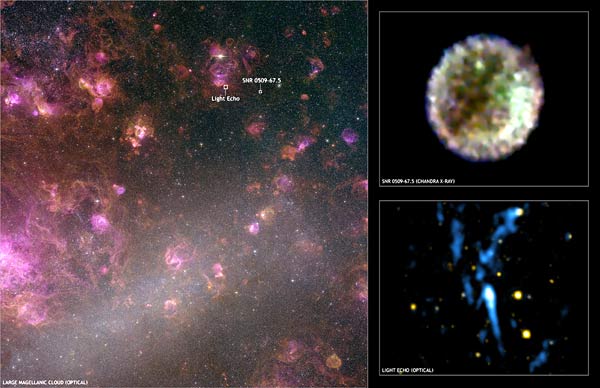Astronomers using data from NASA’s Chandra X-ray Observatory, the Gemini Observatory and ESA’s XMM-Newton Observatory have made the best determination of the power of a supernova explosion long after it was visible from Earth.
By observing the remnant of a supernova that occurred about 400 years ago and a light echo from the initial explosion, the teams have established the validity of a new method for studying a type of supernova that produces most of the iron in the universe. The researchers studied the supernova remnant and the supernova light echo that are located in the Large Magellanic Cloud (LMC), a small galaxy about 160,000 light years from Earth

This is the first time two methods – X-ray observations of the supernova remnant and optical observations of the expanding light echoes – have been combined to study a supernova. Until now, scientists could only estimate the power of explosions from the light seen soon after a star exploded, or from remnants that are several hundred years old, but not from both.
“Classifying outbursts associated with centuries-old remnants is likely to be successful in providing new constraints on additional LMC supernovae as well as their historical counterparts in our own galaxy,” Cook said.
In 2004, scientists used Chandra to determine that a supernova remnant, known as SNR 0509-67.5 in the LMC, was a Type Ia supernova, which is caused by a white dwarf star in a binary system that reaches a critical mass and explodes.
In the new optical study, an estimate of the explosion’s power came from studying the original light of the explosion as it travels through space. Just as sound bounces off walls of a canyon, light waves create an echo by bouncing off dust clouds in space. The light from these echoes travels a longer path than the light that travels straight toward us, and so can be seen hundreds of years after the original explosion.
"People didn’t have advanced telescopes to study supernovas when they went off hundreds of years ago," said Armin Rest of Harvard University, who led the light echo observations. "But we’ve done the next best thing by looking around the site of the explosion and constructing an action replay of it."
First seen by the Cerro-Tololo Inter-American Observatory in Chile, the light echoes were observed in greater detail by Gemini Observatory in Chile. The optical spectra of the light echo were used to confirm the supernova was a Type Ia and to unambiguously determine the particular class of explosion and its energy.
The Chandra and XMM data were then independently used to calculate the amount of energy involved in the original explosion, using analysis of the supernova remnant and state-of-the-art explosion models. The conclusion was that the explosion was an especially energetic and bright variety of Type Ia supernova, providing strong evidence that the detailed explosion models are accurate.
Cook and Nikolaev are active members of the SuperMACHO project, an ongoing five-year microlensing survey of the LMC. The light echo research evolved out of the serendipitous discovery of light echos in SuperMACHO.
Both methods estimated a similar time since the explosion of about 400 years. An extra constraint on the age comes from the lack of recorded historical evidence for a recent supernova in the LMC. Because this star appears in the Southern Hemisphere, it likely would have been seen by navigators who noted similarly bright celestial events, if it had occurred less than about 400 years ago.
Because a Type Ia supernova brightness can be determined from its spectrum or the way its apparent brightness fades, Type Ia supernovae are important tools to study the expansion of the universe and the nature of dark energy.
“This is the first time that spectra were obtained of an ancient supernova, and they were good enough to allow us to identify the supernova as belonging to a particularly bright class of type Ia supernovae,” Cook said
This work also is being extended to other supernova remnants and light echoes.
These results appear in two recently accepted papers in The Astrophysical Journal. The first discusses the spectrum obtained by Gemini, led by Rest. The second, with Carlos Badenes of Princeton as first author, details the Chandra observations of SNR 0509-67.5.





Comments